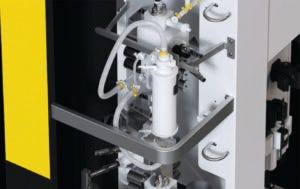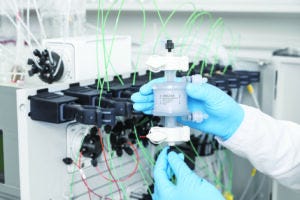- Sponsored Content
- Chromatography
- Process Development
Overcoming the Productivity Bottleneck in MAb CaptureOvercoming the Productivity Bottleneck in MAb Capture
Sponsored by Sartorius

It is no secret that progress toward intensifying monoclonal antibody (MAb) production processes has focused on upstream steps. Although the industry welcomed increased production, that also created bottlenecks in downstream processing, including during capture chromatography steps. Technologies that are intended to alleviate such bottlenecks must meet four important criteria to increase productivity and profitability. They must
• improve productivity of the MAb capture process, such as by purifying more MAbs, using less media, and/or reducing timelines.
• perform as well as or better than current technologies.
• prove to be suitable as a platform approach and performs consistently and reliably.
• scale easily; innovations in MAb capture should work in process development and large-scale manufacturing.
If a new method meets those criteria, then it offers a huge potential for increased production capacity and profitability in a MAb production process.
A 2022 publication in the journal Membranes featured a novel “convecdiff” membrane-based MAb capture platform, designed to provide >10-fold higher productivity over traditional protein A resins (1). The new membrane contains a high-binding gel phase with a short diffusional path length (2–3 μm) and large convective pores, enabling fast mass transport to the gel phase. Those attributes allow for high binding capacities with short residence times. Larger pore sizes in membrane technologies offer the added benefit of being less prone to fouling, and the high permeability gives rise to bed heights of 4 mm or more with low back pressure. The convecdiff membrane platform exhibits many positive attributes, specifically for process intensification. The publication highlighted its increased productivity, product quality attributes that are comparable with those of resins, robust performance of up to 200 cycles, and straightforward scale-up (1). We explore those attributes in more detail below.
Increasing Productivity
Grünberg et al. first reported how a number of factors contributed to increased productivity for the convecdiff membrane platform (1). Similar to working with resin media, increasing the residence time also improved the dynamic binding capacity (DBC) for the convecdiff membrane. With a residence time of one minute, a DBC10% of 48 g/L was achieved, whereas at 12 seconds, the DBC10% was 40 g/L. The convecdiff membrane reached a dynamic binding capacity plateau between one and two minutes. By contrast, resin-based technologies cannot reach a similar plateau before four to six minutes. That observation is unsurprising because resin-based technologies are diffusion limited, meaning that the rate at which binding can occur is limited by the time it takes for antibodies to diffuse into the resin pores.
Improved productivity at a small scale is an important step in the validation of downstream processes. Still, the industry does not consider new technologies in manufacturing seriously unless there is evidence that they can be scaled effectively. The published study demonstrates that purely convective chromatography material shows a steep drop-off in productivity during scale-up (1). However, resin media and the convecdiff membranes maintained their productivity over different device and column sizes and at an order of magnitude higher than the diffusive chromatography material.
Analyzing Comparability
The biopharmaceutical industry is accustomed to the protein A capture chromatography step’s generating a high-quality MAb product. Therefore, an important part of the work by Grünberg et al. was to demonstrate that the novel membrane technology purifies a product with critical quality attributes (CQAs) that are comparable with those of protein A resins. To compare CQAs, researchers evaluated a state-of-the-art resin media in parallel with the membrane. They analyzed DBC, yield, host-cell proteins (HCPs), DNA removal, and protein A ligand leaching. The results showed better membrane performance for DBC10%, DNA removal, and ligand leaching, whereas yield and HCP removal were comparable (1).
The convecdiff membrane achieved a higher binding capacity than the resins reached at residence times of 12 seconds and four minutes, respectively. Overall, the cycle time for the membrane was an order of magnitude lower than that for the resin media, resulting in a 14-fold increase in productivity of the convecdiff membrane compared with the state-of-the-art resin media.

Running up to 200 cycles
Productivity and comparability are valuable attributes of novel chromatography capture technology. However, process scientists must evaluate whether those features are maintained robustly over many cycles. To test this, the research team ran 200 cycles for four different MAbs.
The UV traces for every 20th cycle were plotted for the four MAbs, and each one overlapped precisely, which is a clear indication of the robustness of the technology. The research team also studied pressure traces for each MAb over 200 cycles and found consistent backpressure behavior over the membrane devices for each cycle. The CQAs for different MAbs, including HCP, DNA reduction, and protein A ligand leaching, also were evaluated over each cycle. The analysis shows excellent CQAs for each MAb and high consistency across 200 cycles.
Easy, Seamless Scalability
Maintaining productivity and CQAs during scale-up is vital. Grünberg and colleagues evaluated chromatographic performance of 1.2 mL, 10 mL, and 70 mL devices (1). The first practical point is that there was no change in the bed height for each device, which simplifies scale-up with the new technology. Further, scale-up was supported by keeping flow rates constant so that scaling can be performed based on capacity.
It was essential to understand whether important parameters were consistent across the three membrane scales. The yield was comparable across all three scales, although it was marginally better in the 70-mL device. Removal of HCP and host-cell DNA also was achieved effectively at all scales.
The similarity between results at each scale from the convecdiff membrane technology enables the use of membranes in process development with the confidence that they will adapt easily to larger-scale production.
A Scalable Solution
The data presented by Grünberg et al. showcase a new chromatography solution that can deliver improved productivity over several different volume scales (1). Those productivity increases were robust, with four different MAbs run over 200 cycles. The findings demonstrate that the convecdiff membrane is a truly scalable solution, providing better than a 10-fold higher productivity over that achieved with standard protein A resins.
Reference
1 Grünberg, et al. Scalable, Robust and Highly Productive Novel Convecdiff Membrane Platform for MAb Capture. Membranes (Basel) 12(7) 2022: 677; https://doi.org/10.3390/membranes12070677.0375/12/7/677.
Corresponding author Mario Grünberg is a process engineer for modalities and analytics; [email protected]. Kim Beatrice Kuchemüller is a scientist/engineer for modalities and analytics; and Ricarda A. Busse is a product manager for chromatography consumables; all are with Sartorius in Germany.
You May Also Like





